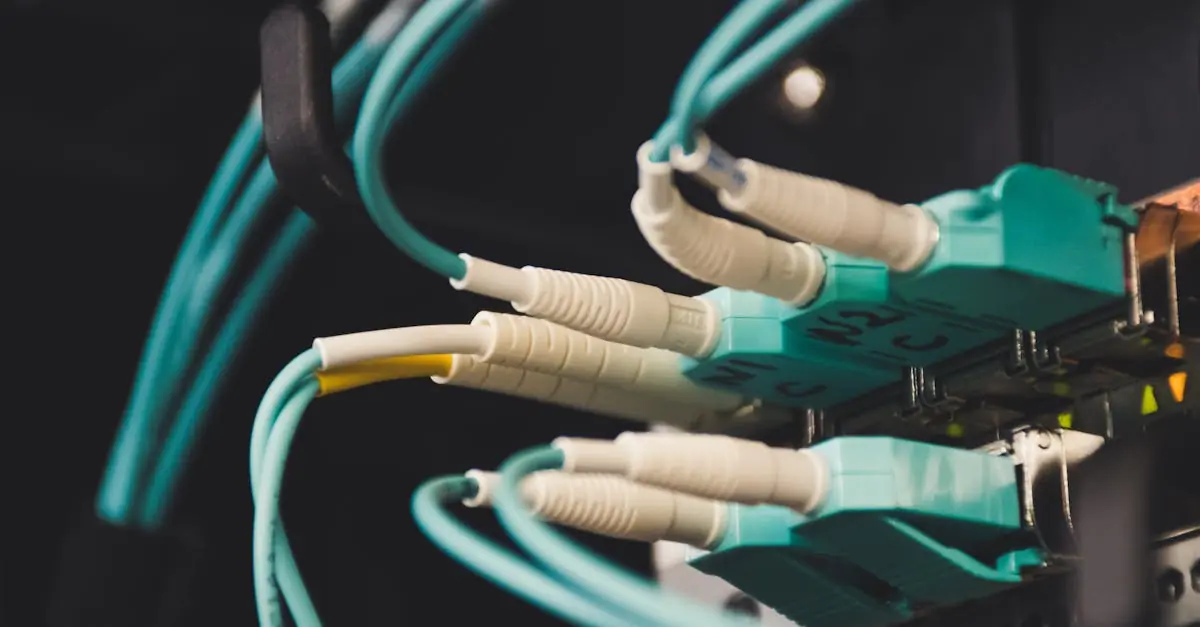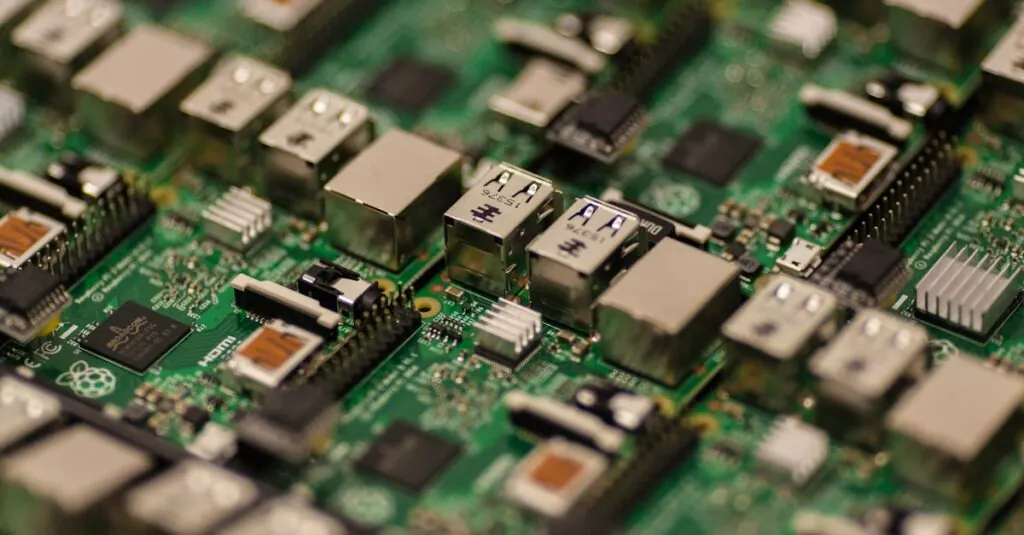Table of Contents
ToggleIn today’s fast-paced digital world, a reliable broadband connection isn’t just a luxury; it’s a necessity. Imagine trying to binge-watch your favorite show only to be greeted by the dreaded buffering wheel. It’s like waiting for a tortoise to cross the finish line while your popcorn goes cold. With the right broadband, life’s little annoyances can turn into seamless streaming and uninterrupted browsing.
Overview Of Broadband Connection
Broadband connections provide high-speed internet access, enabling smooth online experiences. Users benefit from faster download and upload speeds compared to traditional dial-up connections. In 2023, broadband connections reach average download speeds of 100 Mbps, allowing multiple devices to connect simultaneously.
Fiber-optic, DSL, cable, and satellite represent the primary types of broadband technology. Fiber-optic connections offer the fastest speeds, often exceeding 1 Gbps. Cable connections maintain speed and reliability while sharing bandwidth among users. DSL connections utilize existing telephone lines but generally provide slower speeds than fiber. Satellite connections serve remote areas where other types are unavailable, though they may experience higher latency.
Accessing broadband is essential for various activities, such as streaming, gaming, and remote work. Streaming platforms require a minimum of 25 Mbps for high-definition content. Gaming often necessitates lower latency, making fiber-optic connections ideal for competitive players. Remote work also thrives with stable connections, supporting video conferencing and large file transfers.
Understanding the significance of broadband connections drives the demand for reliable service providers. Surveys indicate that 60% of consumers prioritize internet speed when selecting a provider. Many households view a dependable connection as vital for education, employment, and entertainment.
Legislation promoting broadband access has emerged, seeking to bridge the digital divide. In many regions, government initiatives work towards expanding connectivity and affordability. These efforts aim to ensure equitable access to high-speed internet for all, fostering economic growth and social well-being.
Types Of Broadband Connections
Broadband connections come in various forms, each catering to specific needs and areas. These types provide different speeds and capabilities, helping users choose the most suitable option for their internet activities.
DSL (Digital Subscriber Line)
DSL technology utilizes existing telephone lines for internet connectivity. This type offers download speeds ranging from 1 to 100 Mbps, depending on the provider and distance from the service hub. Combining affordability with reliability, it serves residential users effectively. Many households choose DSL for everyday internet tasks, such as browsing and streaming. The ability to use a phone and the internet simultaneously adds to its convenience.
Cable Broadband
Cable broadband employs coaxial cables, commonly used for television services, to deliver internet connections. Speeds can reach up to 1 Gbps, making it suitable for heavy internet usage and multiple users. Users often select cable broadband for its excellent performance during peak usage times. Additionally, cable services do not rely on phone lines, ensuring stability and speed. Many consumers appreciate cable for seamless streaming, online gaming, and video conferencing.
Fiber Optic Broadband
Fiber optic broadband stands out for its exceptional speed and reliability. Utilizing strands of glass or plastic to transmit data as light, this technology supports download speeds of up to 10 Gbps. Fiber offers symmetrical upload and download speeds, enhancing user experiences for activities like remote work and 4K streaming. Many customers prioritize fiber optics due to its future-proof nature, providing scalable options for growing bandwidth demands. Its expansion continues to bridge gaps in internet access, significantly improving overall service quality.
Satellite Broadband
Satellite broadband utilizes satellites to provide internet service, especially in rural and remote areas. Download speeds typically range from 12 to 100 Mbps, although latency can be an issue due to the signal’s distance to the satellite. This type of connection is essential for users without access to traditional wired services. Many remote workers and travelers benefit from satellite technology when other options are unavailable. Providers now offer improved equipment, minimizing latency and enhancing overall performance.
Benefits Of Broadband Connection
Broadband connections provide essential benefits that enhance the online experience. Users enjoy various advantages, particularly in accessing high-speed internet.
High-Speed Internet Access
High-speed internet access transforms daily activities. Broadband connections, with average speeds of 100 Mbps, support seamless browsing and downloading. This speed allows multiple devices to connect without experiencing lag. Users can stream content, participate in video calls, and download large files efficiently. Whether for personal or professional use, a reliable broadband connection makes online tasks enjoyable and productive.
Improved Streaming Experience
Improved streaming experience becomes evident with strong broadband connections. Users expect smooth playback of videos, especially in 4K resolution. High-speed connections avoid buffering, leading to uninterrupted viewing. Multiple users can stream their favorite shows simultaneously without compromising quality. Enhanced download speeds make it easy to enjoy platforms like Netflix or Hulu. This ensures that entertainment options remain accessible and enjoyable for everyone in the household.
Enhanced Remote Work Capabilities
Enhanced remote work capabilities depend on a reliable broadband connection. With average download speeds of 100 Mbps, employees can connect to work resources without delays. Video conferencing software operates smoothly, promoting effective collaboration among team members. Fast upload speeds facilitate sharing large documents quickly. Consequently, businesses benefit from increased productivity and efficient communication. Trying to navigate remote work without strong broadband access often results in frustration and hindered workflow.
Choosing The Right Broadband Connection
Choosing the right broadband connection is crucial to ensure an optimal online experience. Evaluating specific requirements helps determine the most suitable option.
Assessing Your Internet Needs
Identifying internet usage patterns clarifies necessary speeds and bandwidth. Users focused on streaming in 4K or gaming typically require higher speeds, often around 100 Mbps or more. Those handling basic tasks like email or browsing might find 25 Mbps adequate. Considering the number of devices also matters; multiple users often increase the required speed. It’s essential to plan for future needs, especially with smart home devices becoming more common.
Comparing Provider Plans
Evaluating provider plans involves looking at speed, pricing, and contract terms. Many providers offer various packages, often ranging from 25 Mbps to 1 Gbps at different price points. Understanding latency issues is also vital, particularly for satellite connections. Promotions may influence initial costs, but long-term pricing stability ensures budget predictability. Additional features like bundled services or no data caps can also sway decisions. Reading customer reviews often reveals service reliability levels, helping consumers make informed choices.
Common Issues With Broadband Connection
Broadband connections often face various issues that can impact user experience. Understanding these common problems can help users troubleshoot effectively.
Connectivity Problems
Connectivity problems frequently plague broadband users. Disruptions in service can stem from weak signals, improper setup, or outdated equipment. Devices positioned far from routers often experience reduced signal strength. Environmental factors like walls and interference from electronic devices can exacerbate these issues. Regularly updating router firmware can enhance connectivity. Users also benefit from double-checking equipment connections and placement for optimal performance.
Slow Speeds
Slow speeds frustrate many broadband users. High-speed expectations often clash with reality, especially during peak hours when network congestion occurs. Users typically require at least 25 Mbps for basic activities. Streaming services necessitate higher speeds, usually around 100 Mbps for 4K content. Poorly optimized networks or inadequate bandwidth allocation may lead to underperformance. Sometimes, switching to a wired connection provides a faster and more stable experience. Users should perform speed tests periodically to check their actual speeds against what their provider advertises.
Service Interruptions
Service interruptions impact broadband reliability. Outages often occur due to maintenance work or natural disasters affecting infrastructure. Customers may find themselves disconnected unexpectedly, leading to inconvenience and frustration. In these cases, contacting the internet service provider can provide clarity on restoration timelines. Users should also monitor social media or the provider’s website for updates during known issues. Keeping a record of outages can help users negotiate with providers for potential service credits or better plans.
Conclusion
A reliable broadband connection has become essential for navigating today’s digital landscape. With the right technology in place users can enjoy seamless streaming gaming and remote work experiences. The variety of broadband options available ensures that everyone can find a solution that fits their needs whether they require high speeds for intensive tasks or a more modest connection for everyday activities.
As consumers become more discerning in their choices understanding the nuances of different broadband types and providers is crucial. By prioritizing speed reliability and service quality individuals can enhance their online experiences and stay connected in a fast-paced world. Ultimately investing in the right broadband connection pays off in improved productivity entertainment and communication.




